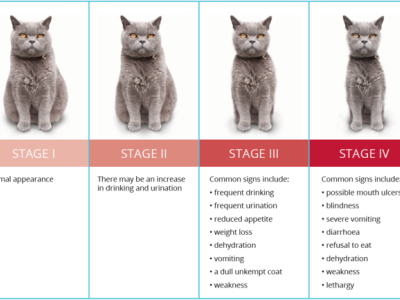Hyperthyroidism
Hyperthyroidism is a disease of the Thyroid gland, where it is over-producing thyroid hormone. The thyroid gland is found at the front of the neck. Thyroid hormone is used by the body to control metabolic rate.
Elevated thyroid hormone levels causes the body to start to work in overdrive and can cause serious changes with most organs in the body, in particular prolonged high heart rate causing heart enlargement, heart disease, high blood pressure (hypertension) and kidney damage as well as changes to the liver.
This over production of hormone is generally due to a non-cancerous tumour, but in 2% of cases it can be associated with a malignant (cancerous) tumour. With treatment, especially early treatment this condition can be controlled and in some cases cured (with radioactive iodine therapy).
What to look for at home:
- Increased thirst and urination
- Ravenous appetite, often with weight loss
- Occasional or increased vomiting or diarrhoea
- Unkempt coat.
- Signs of high blood pressure – often manifesting as sudden onset blindness.
- Behaviour changes – particularly an increase in aggressive tendencies.
- Palpable lump at front of the neck.
If you are concerned about any of these changes please contact the clinic and organize a health check.
What can your vet do to check for Thyroid disease?
Your vet can check your cat’s Thyroid hormone levels by performing blood tests – the total T4 is the standard test. The total T4 can be reduced in some cases due to concurrent illness or other problems. For those cases that clinically appear consistent with hyperthyroidism, but the total T4 is equivocal, a free T4 test may also be required to confirm hyperthyroidism.
Routine blood tests (including total T4 and renal enzymes) at least annually as well as 6 monthly blood pressure checks, regular preventative care exams performed by your vet and monitoring for changes at home can assist us in diagnosing hyperthyroidism earlier.
What can you do to prevent Hyperthyroidism?
Unfortunately there is little we can do to prevent Hyperthyroidism, but early detection (through monitoring and blood tests) and treatment before the disease becomes advanced or causes changes in other body systems can make a huge difference to the quality and length of your cat’s life.
What can we do to treat Hyperthyroidism?
There are several different treatment options available for cases where hyperthyroidism has been diagnosed.
1. Carbimazole tablets.
These are the most cost effective option for treating hyperthyroidism. Depending on your individual cat’s need and how they react to the medication will determine how many tablets they will require each day. These are generally a twice daily dosing and will be required for the rest of your cat’s life. Regular total T4 and kidney enzyme testing will be required also to ensure that the medication is working and there is no underlying kidney damage.
2. Transdermal methimazole.
Methimazole is the active part of carbimazole. It can be made into a gel that is absorbed across the skin and is particularly useful in cats that are difficult to tablet. It is applied to the un-haired inner part of the ear morning and night. Gloves must always be worn when applying it and, like the oral medication, will be required for the rest of your cat’s life. Regular total T4 and kidney enzyme testing will also be required also to ensure that the medication is working and there is no underlying renal damage.
3. Radioactive Iodine therapy.
Thyroid hormone is produced from iodine. This is selectively taken up by the cells producing the thyroid hormone, within the thyroid gland. This means that only those cells that are overproducing the thyroid hormone will uptake the radioactive iodine (as the normal cells are inhibited from producing thyroid hormone by the persistently high levels in the blood stream). The radioactive element of the iodine then causes the selective destruction of those cells that uptake it. Thus only the cells overproducing thyroid hormone are destroyed, leaving the normal cell and a functioning thyroid gland. This can be a permanent treatment for hyperthyroidism.
It is important to start on either oral carbimazole or transdermal methimazole for at least a month and checking their kidney enzymes before commencing radioactive iodine therapy, as in some cases hyperthyroidism can mask kidney disease. These cases would generally not be considered suitable for radioactive thyroid treatment.
While our clinic does not currently have the facilities to provide this therapy, we are happy to arrange referral for this treatment at your request.
4. Surgical removal of the Thyroid gland.
Due to the advent of radioactive iodine therapy this is a less common treatment and involves the removal of the entire thyroid gland (including the normal tissue). There are some side effects and a higher risk of complications. Please speak to your vet for more information regarding this treatment.
In summary- Hyperthyroidism is a manageable and, in some cases, a curable condition that if treated can significantly improve the length and quality of your cat’s life.![]() Hyperthyroidism PDF188.78 KB
Hyperthyroidism PDF188.78 KB

